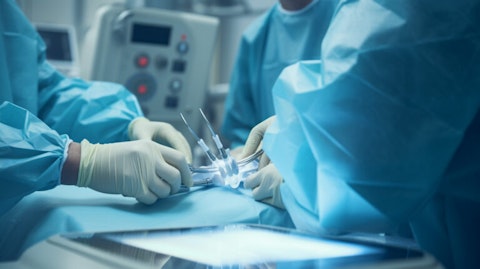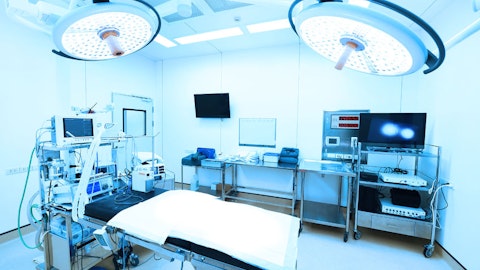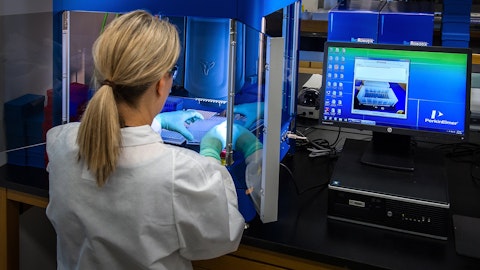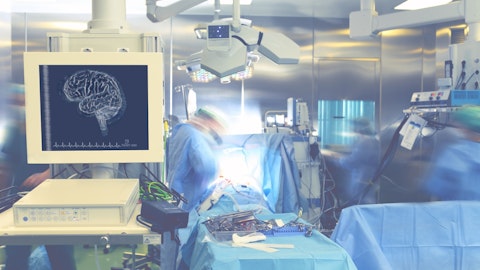Integra LifeSciences Holdings Corporation (NASDAQ:IART) Q3 2023 Earnings Call Transcript October 25, 2023
Integra LifeSciences Holdings Corporation misses on earnings expectations. Reported EPS is $0.76 EPS, expectations were $0.78.
Operator: Good day, and thank you for standing by. Welcome to the Integra LifeSciences’ Third Quarter 2023 Financial Results Conference Call. At this time, all participants are in a listen-only mode. After the speakers’ presentation, there’ll be a question-and-answer session. [Operator Instructions] Please be advised, that today’s conference is being recorded. I would now like to introduce your host for today’s call Chris Ward, Senior Director of Investor Relations. Please go ahead.
Chris Ward: Thank you, Justin. Good morning, and thank you for joining the Integra LifeSciences third quarter 2023 earnings conference call. Joining me on the call are Jan De Witte, President and Chief Executive Officer; and Lea Knight, Chief Financial Officer. This morning, we issued a press release announcing our third quarter 2023 financial results. The release and corresponding earnings presentation, which we will reference during the call, are available at integralife.com, under Investors, Events and Presentations and a file named Third Quarter 2023 Presentation. Before we begin, I would like to remind you that many of the statements made during this call may be considered forward-looking statements. Factors that could cause actual results to differ materially are discussed in the company’s Exchange Act reports filed with the SEC and in the release.

A surgeon in an operating room with an orthopeadic medical device ready for use in bunion treatment. Editorial photo for a financial news article. 8k. –ar 16:9
Also, in our prepared remarks, we will reference reported and organic revenue growth, and organic revenue growth excluding Boston. Organic revenue growth excludes the effects of foreign currency, acquisitions, divestitures, as well as discontinued products. Organic revenue growth excluding Boston also excludes the revenues from products manufactured in our Boston facility in both periods. Management believes that excluding revenues from all products manufactured at the Boston plan provides useful information when evaluating the company’s organic growth because of the unusual nature of the manufacturing stoppage and voluntary global recall. Unless otherwise stated, all the segregated and franchise level revenue growth rates are based on organic performance.
And lastly, in our comments today, we will include certain non-GAAP financial measures. Reconciliations of any non-GAAP financial measure can be found in today’s press release, which is an exhibit to Integra’s current report on Form 8-K filed today with the SEC. With that, I will now turn the call over to, Jan.
Jan De Witte: Thank you, Chris, and good morning, everyone. I want to begin our remarks today with an update on our progress on the quality system remediation at our Boston manufacturing facility and our return to market plans for SurgiMend and PriMatrix and our private label products. We recognize this remains top of mind for our investors and analysts as it is for me and our leadership team. So before going into the broader business updates, let’s turn to slide four. As a reminder, during our last call, we told you we expected to resume manufacturing by the end of the fourth quarter this year. We also highlighted that the final external audits of the updated quality system would be conducted in the first quarter 2024, with results submitted to the FDA by the end of March 2024.
This then paves the way for the resumption of commercial distribution in the mid-to-late second quarter of 2024. For the past four months, we have worked diligently on the remediation of our quality system in Boston, consistent with the holistic plan we built in alignment with the FDA expectations. We’ve bolstered our Boston operations leadership, quality expertise, project management capabilities and capacity with internal resources, and we further engaged external subject matter experts as well. We recently completed several interim external reviews that confirmed the adequacy of the changes we are making. So I’m pleased to report that as a result of all this progress, we remain on schedule with the restart timelines we communicated last quarter.
Also want to provide insight into a couple of critical milestones along the way. We have plans for an external review shortly after we restart of the factory. This review will be in addition to and in preparation for the independent audits we intend to submit to the FDA before the end of March. These activities will then clear the way for us to build sufficient inventory ahead of our re-launch into the market. In the meantime, we have also been working closely with our customers to manage through the recall and have now substantially assessed and reconciled our customer’s inventory. Our Tissue Technologies sales team is also working closely with our customers to facilitate product substitutions in about 10% to 15% of cases, on-track with our expectations.
And finally, our manufacturing and clinical progress keeps us in-line for PMA approval for SurgiMend in the first half of 2025. The right side of the slide shows the updated financial impact. Financial results for the third quarter [both] (ph) the effect of $7 million of returns, which Lea will discuss in more detail, in addition to the lost sales for the third quarter, we previously communicated. The additional returns impact albeit isolated to the third quarter only, has impacted our revenues by $7 million. Adjusted gross margin by 60 basis points and adjusted earnings per share by $0.07. In summary, we’re making significant headway towards completing the necessary remediation requirements in Boston to bring these critical technologies back to the market for our customers and their patients, and we are on-track with our communicated timelines.
With that, let’s move to slide five, for some overall third quarter business highlights. I am starting on the right side of this page. Our third quarter revenues were $382.4 million, and decreased by 0.4% on an organic basis. These results reflect the Boston impact, including the $7 million return reserve increase, which offset otherwise strong organic growth performance. Our topline performance was below our guidance for the quarter, and I realized this will be frustrating for our investors, but we are making things right with our customers and we’re taking the necessary steps to get through this period as quickly as possible to position our business for long-term sustainable growth again. Our end markets for both CSS and Tissue Technologies remain strong and continue to grow in-line with the expectations we outlined during our May Investor Day.
In the third quarter, we saw strong demand for our unique technologies across the portfolio. Excluding the Boston impact, we delivered organic growth of 7.1% at the high end of our LRP range. In our CSS business, we saw organic growth of 7.4% above our LRP range for this segment. In our Tissue Technologies business, we delivered organic growth of 6.7%, excluding the Boston impact. And our international growth was strong once again at nearly 12%. Now turning to our bottom line. Our third quarter adjusted earnings per share came in at $0.76 within our July guidance range. This result included the approximate $0.07 headwind from the increase in the Boston recall return provision. As we look beyond our third quarter revenue results and back to the left side of the page, we continue to deliver several proof points along our path to the growth commitments we laid out during our Investor Day.
First, on innovating for [ad comps] (ph) we’re excited about return to market of the CereLink monitors for our customers and their patients. We re-launched in our first international markets, and we’ll be broadening our re-entry in the fourth quarter. We also filed the updated 510(k) in the U.S. in mid-September with an expected launch of the product in U.S. in the first quarter, early in the first quarter 2024. In addition to CereLink, we also submitted 510(k) for the next generation Aurora Surgiscope, which brings enhanced usability to the 8 millimeter Surgiscope based on customer learnings from our initial limited releases. Second, we advanced our international growth strategy with further geographic expansions, expansions of our CUSA platform, and registrations of DuraGen, DuraSeal, Mayfield, and our Duo LED lighting in EMEA and Latin America.
As well as the launch of DuraGen Plus in China. Although each product alone won’t be material to our overall revenue growth, collectively, they showcase our strategy to bring our existing technologies to international markets and leverage our commercial footprints. We also made a significant step forward with our In-China-for-China strategy by starting the build out of a leased manufacturing facility near Shanghai. And then third, on an inorganic opportunities and broadening our impacts on care pathways, we’re delivering on the successful integration of the SIA business with greater than 100% revenue growth year-to-date and advancement of our clinical program for a second PMA approval in the high growth breast reconstruction market. We have also expanded our UBM platform with a 510(k) clearance for MicroMatrix Flex, bringing the first organic [NPR] (ph) line to the A-Cell UBM portfolio.
We’ve also strengthened our executive leadership by appointing Chantal Veillon, as Chief Human Resources Officer. Chantal, brings a rich experience in driving cultures of talent enrichment, leadership development, and accountability. And finally, sustainability remains an integral part of how we do business. Effective ESG Management enables us to produce lifesaving products, reduce business risks, minimize our environmental impact and drive strong financial results. As part of our continued commitment to transparency and accountability we issued our second annual ESG report for 2022. This report details the progress we have made, particularly in our commitments to our customers and patients, building a more rewarding diverse and inclusive workforce and improving our environmental sustainability.
And it also lays out our plans for the coming year. And with that, I will now turn it to Lea, for updates on our financial results and full year guidance.
Lea Daniels Knight: Thank you, Jan. Now on to our third quarter financial results and I’ll begin on slide six. Our third quarter total revenues were approximately $382 million, representing a decrease of 0.7% on a reported basis and a decrease of 0.4% on an organic basis. As Jan mentioned, the increase of the Boston returns provision was a headwind to our third quarter results, impacting our revenues and organic growth and driving declines in our gross margins, adjusted EBITDA margins, and adjusted EPS. In the second quarter, we estimate the returns provision based on the best available information we had at that time. However, during the third quarter, we’re working closely with our customers to assess and reconcile their returnable inventory, we recognize the need to make an adjustment to our returns provision.
We believe we have adequately provided for any remaining returns. While Boston remains a significant headwind, there is much more to our results for the quarter. We continue to see solid performance across our business outside of Boston with organic growth of 7.1%, once again, demonstrating the breadth and resilience of our portfolio. Adjusted gross margin for the quarter was 64.6%, down 210 basis points versus the third quarter of 2022, primarily driven by the Boston impact. Adjusted EBITDA margin for the quarter was 23%, down 430 basis points and adjusted earnings per share were $0.76 down $0.10 compared to the prior year. Gross margin pressures, largely driven by Boston, are planned growth investments and the year-one dilution from the SIA acquisition impacted our adjusted EBITDA and EPS metrics.
If you turn to slide seven, I will go deeper into the third quarter revenue performance of our CSS segment. Reported third quarter revenues in CSS were $268 million, an increase of 7.4% on a reported and organic basis from the prior year. Overall the CSS segment delivered quarterly result exceeding the growth range outlined during our Investor Day. Global Neurosurgery sales were up 8% with low-double-digit growth in CSF Management driven by Certas Plus valves, low-double-digit growth in Neuro Monitoring driven by ICP microsensors, and high-single-digit growth in Dural Access and Repair, driven by DuraGen, DuraSeal and Mayfield. We saw a mid-single-digit decline in Advanced Energy due to the timing of CUSA capital orders, offsetting some favorable timing benefits in the second quarter.
Overall, excluding CereLink, capital sales for the quarter were down low-double-digits due to CUSA capital. Year-to-date, our capital sales excluding CereLink monitors are up mid-single-digits, and we remain encouraged by the continued momentum in the market for capital and the demand funnels for our capital portfolio. Instruments grew approximately 5% benefiting from strong demand. The performance of our instruments business continues to exceed long-term growth expectations for the market with high-single-digit growth year-to-date as the market remains stable and the team continues to take market share and win new business. Shifting to International. Sales grew low-double-digits in the quarter, led by China, indirect markets, Australia and Canada.
Our growth in China is driven by our regional expansion strategy outlined at our Investor Day with our team in China delivering double-digit growth with strong performance across the Neuro portfolio as we grow beyond tier one city. Moving to our Tissue Technologies segment on slide eight. Tissue Technologies was down 15.6% on a reported basis and 15.1% on an organic basis compared to the prior year, excluding Boston organic growth was 6.7%. Third quarter sales in the Wound Reconstruction franchise, which includes a majority of the Boston products, decreased by 15%, excluding the recalled products, we experienced organic growth of 7.5% driven by double-digit growth in MicroMatrix, Cytal, Gentrix, and our amniotic portfolio as our sales team refocused their selling efforts this quarter following the recall related activities in the second quarter.
We are pleased to see such strong demand and commercial execution in this franchise, which continue to provide us with confidence in the long-term growth potential of this business. In our private label franchise, sales declined 14% versus last year due to lost sales from private label partners associated with the recall. And finally, international sales in Tissue Technologies were down double digits due to Boston, which offset double-digit growth and Integra Skin, MicroMatrix, and Cytal. Turning to slide nine, I will now review the rest of our third quarter P&L metrics. As we look at our gross margin and profitability metrics, we continue to see Boston as the primary headwind to our gross margins representing an approximate 180 basis point impact with 60 basis points coming from the third quarter return provision adjustment and approximately 120 basis points coming from the impact of the lost sales from the recall.
The remaining 30 basis point impact is due to production inefficiencies in other sites. In addition to the impact to gross margins, our adjusted EBITDA margins and adjusted EPS also reflect planned investments and the strategic priorities for the business, we originally outlined in the beginning of the year, including the year-one dilution from the SIA acquisition. On our second quarter call, we highlighted these investments as critical to our long-term growth and we continue to protect them. Finally, we saw an approximate 150 basis point benefit to our tax rate in the quarter from jurisdictional income mix and improved utilization of R&D and international credits. The third quarter tax rate also included a year-to-date true up. We expect approximately 50 basis points of the benefit to carry forward beyond 2023.
If you turn to slide 10, I will provide a brief update on our balance sheet, capital structure, and cash flow. During the quarter, operating cash flow was $27 million and free cash flow was $14 million, reflecting increased working capital primarily from investments in inventory bills. Our investment in inventory is to rebuild our safety stock levels and increased inventory for our European markets in preparation for EU MDR. Free cash flow conversion was 43% on a trailing 12-month basis. Our balance sheet remains strong, with ample liquidity support our short and long-term plans. As of September 30th, net debt was $1.2 billion, and our consolidated total leverage ratio was three times. The company had total liquidity of $1.5 billion, including $274 million in cash and the remainder available under our revolving credit facility.
Our balance sheet flexibility has enabled us to execute the accelerated share repurchase we announced on our July earnings call. If you turn to slide 11, I will provide an update to our consolidated revenue and adjusted earnings per share guidance for the fourth quarter and full year 2023. Fourth quarter revenues are forecasted to be between $397 million to $403 million representing reported growth in the range of approximately minus 0.4% to positive 1.1%, and organic growth in the range of approximately minus 0.8% to positive 0.7%. Our reported revenues reflect the strengthening U.S. dollar. Excluding Boston, we are forecasting organic growth of approximately 5.1% at the midpoint, driven by continued strong global demand for our products. For the full year 2023, revenues are forecasted to be in the range of $1.541 billion to $1.547 billion, which reflects the third quarter additional Boston recall returns provision and current FX rates.
The updated guidance represents reported growth of minus 1.1% to minus 0.7% and organic growth in the range of approximately positive 0.1% to 0.5%. Excluding Boston, we are forecasting organic growth of approximately 6%, reflecting the stable growth in our markets and strong global demand and performance we have demonstrated year-to-date. Turning to adjusted earnings guidance for the fourth quarter, we expect adjusted EPS to be in the range of $0.89 and $0.93 down from the prior year, driven by the Boston recall, our planned strategic investments, OpEx management to offset part of the impact of the recall, and our tax rate improvements. During our July earnings call, we estimated a modest improvement in gross margin for the full year. We saw an impact to our gross margins in the third quarter due to the increased Boston recall returns and unfavorable sales mix, driven by stronger international performance.
We are also seeing a slower uptake on net productivity and yield improvements. We now expect a moderate decline in gross margins versus 2022. Our full year adjusted EPS guidance is being revised to $3.10 to $3.14 per share reflecting the strength in the U.S. dollar, Boston recall returns provision, adjusted gross margin outlook, second half expense management, our recently completed ASR, and the tax favorability. Now, I will turn the call back over to, Jan.
Jan De Witte: Thank you, Lea. Please turn to slide 13 to conclude our prepared remarks. And as we wrap up, I’d like to cover a few highlights from what Lea and I walked you through. First, our progress in addressing the Boston facility and returning to the market remains on-track. Interim external reviews confirms the adequacy of our remediation plan and the changes made so far, and they reflect significant steps made towards the resumption of manufacturing by the end of the fourth quarter ‘23 and commercial distribution in mid-to-late second quarter ‘24. Product substitutions are within the expected range of 10% to 15%, highlighting the breadth and depth of our Tissue Technologies portfolio, and we remain on target for SurgiMend PMA approval in the first half ‘25.
Second, despite the Boston recalls impact and the additional returns provision, our underlying third quarter growth performance has been strong. Our Global CSS and Tissue Technologies segments, excluding Boston, delivered over 7% its organic growth. Many of our product lines exhibit double-digit growth, underscoring the appeal of our diversified portfolio and the health of our markets. Additionally, our international business has delivered strong growth again. And finally, related to our long range commitments, we’ve taken a big step, bringing CereLink back in our international markets, and with the regulatory filing, CereLink should be back in U.S. early first quarter. Advancing our growth drivers with a 510(k) submission for the next generation Aurora Surgiscope, and we continue to progress on our breast reconstruction PMAs. We’re also continuing to expand our international presence and portfolio, and we’re investing to capture future international potential.
In conclusion, our journey has been marked by both significant achievements and significant challenges. The radiations and improvements we’re bringing to Integra are making us stronger and are de-risking the path to our LRP, and will enable us to consistently deliver our financial commitments. As an organization, we remain dedicated to our purpose of advancing healthcare to restore patients’ lives. And we’d like to thank our dedicated teams for their unwavering support and hard work. Together, we’re shaping a future in which we continue to make a meaningful impact on patients and deliver lasting value to our shareholders. Thank you for your time this morning. This concludes our prepared remarks. And operator, we can open the lines for questions.
Operator: Thank you. [Operator Instructions] And our first question comes from Young Li from Jefferies. Your line is now open.
See also 20 Greenest Countries in the World and 12 Defensive Healthcare Dividend Stocks To Invest In.
Q&A Session
Follow Integra Lifesciences Holdings Corp (NASDAQ:IART)
Follow Integra Lifesciences Holdings Corp (NASDAQ:IART)
Young Li: Thanks so much for taking our questions. This is actually Young, in for Matt. I guess, maybe to start, just on Boston, I mean, it seem like it had a bigger impact than expected. Good to hear the substitution rates are in-line. But maybe if you can provide a little bit more color on, why the $7 million increase in return provisions, and as you’re going forward, Boston impact assumptions right-sized, maybe you can also talk a little bit about customer attrition and how you can regain their business, post remediation?
Lea Daniels Knight: Yes. So when I talk about, kind of, the impact that we saw in Q3, and then Jan, I can turn it over to you —
Jan De Witte: Yes.
Lea Daniels Knight: …for any sort of customer dynamic. And thank you for the question. So, as we mentioned, so it’s — when we announce the recall and then in our Q2 call, we were about, call it, 45 days post the recall. So at that point, while we had obviously already done some initial work working with customers, we had limited visibility to all of the inventory that was out there and potentially returnable. So based on the information we had at that time, we projected what the appropriate provision would be for returns. Since that time, as you can imagine, we’ve had an opportunity to now work with essentially all of our customers and get more, even more insight and visibility into their inventory. To be able to, to more accurately assess what’s returnable.
And so that’s the incremental $7 million that you saw impact our Q3 results. And so we’re confident based on the work that we’ve done that and the visibility that we now have, that we’ve accurately captured that and provided for it in our reserve, as of the end of September. So what that means is, as we move forward, we wouldn’t expect to see any impact from a P&L perspective for any future returns, because it’s been provided for us as part of our reserve. And that’s the only incremental Boston impact we saw for Q3. So as you think about the full-year dynamic for 2023, we had originally called out a Boston impact of about $60 million topline. That number is now $67 million topline. We had called out an EPS impact of $0.35, that number is now $0.42, but it is isolated to 2023.
In our July call, we had mentioned, we’ve called out, while we did not provide guidance on 2024, we did articulate our expectations of the Boston impact on 2024. And at that time, we had communicated an impact of $50 million topline and $0.30 to EPS. That projection remains unchanged. As I mentioned, the nature of what happened in Q3 really was isolated to returns and does not have an impact on what we called in 2024. So hopefully that answers your question.
Young Li: Yes. That’s been very clear. Appreciate the color. I guess maybe —
Jan De Witte: Yes, Matt. Matt, you had, your second question. Okay, if I answer that one?
Young Li: Yeah. So thanks for that. So for the follow-up question, I guess, was wondering, in terms of, share loss, how much do you expect to recapture, following the re-launch in mid ‘24? And how are the impacted reps during this time? If you can comment about what they’re focused on, what they’re doing?
Jan De Witte: So, let me get in three, three parts, right, all linked to how are we prepping for commercial return. First, the sales force, the reps, a lot of attention, both from a perspective of communication, but also compensation, we’re planning with them. We stay close to them, keeping closely informed. We definitely have some higher attrition than normal, but well in control, I would say. Second, yes, that sales force remains in touch with our customers. And that’s where the substitution is important, both in the Wound Reconstruction as well as in the Surgical Reconstruction. We have substitute products, which that allows sales force to be in the door, be in the procedures, and work with customers to maintain the relationships and as we indicated, in between 10% to 15% of the procedures that have substitutes.
And then third, from a re-launch perspective, our sales teams and sales leadership estimates that, yes, we will be back to about 100% of our business in about 12 months after the allowance. And that’s really driven by two elements; one, the strength of the relationship; and then second, the merits of the products that come out of our Boston facility. These were products that were getting market share and before we did a recall, all for good reasons. And those reasons will be still there when we announce [indiscernible].
Young Li: All right. Thank you so much.
Operator: And thank you. And one moment for our next question. And our next question comes from Vik Chopra from Wells Fargo. Your line is now open.
Vik Chopra: Hi, good morning and thanks so much for taking the questions. Two for me. I’ll start with the first one. So, we’ve heard about increased anti-corruption issues in China that could make access to hospitals more difficult. Maybe just remind us what percent of your sales are from China and what impact this could have on Integra? And then I just had a follow-up.
Jan De Witte: Okay. So I’ll take that, Vik. Our China sales about 5%, 6% of our total, specifically to your question on the anti-corruption, I think like many, many companies, that we’ve seen confusion and some freezing of some commercial and professional education activities in the first week, right. Specifically in the month of August, we’ve seen it improve over September and then continue to significantly improve over October. When we look as our impact on the business, it’s not material. And that’s linked to our portfolio we have in China. That, that 5%, 6% of total is essentially neurosurgery portfolio, a lot of consumables and therefore linked with procedures. Now, neurosurgery procedures are cannot be delayed for significant times.
We’ve seen that also during COVID. And in addition, the procedures themselves don’t lead to themselves to too much judgments or overuse. Okay. So the tightening of some controls doesn’t translate into tightening what goes on with neuro procedures. And in addition, we have strong internal controls and policies in place. So, from a — how we operate, there’s no need or no change that we’re using in our process. So, yes, overall that, we’ve seen some of the ways in August, but as you see in our third quarter numbers and what we expect is we have no material impact on our business.
Vik Chopra: Great. Thank you for that color. And then my follow-up question, pretty topical, I guess. It’s on GLP-1. Maybe just any thoughts on what you have, about GLP-1’s near-term and long-term, kind of, what it means for Integra. I just don’t think that the impact is as clear for Integra, as for some other companies. Thanks so much for taking the questions.
Jan De Witte: Yes. So GLP-1, we have not seen, and we don’t foresee any material impact. That’s also what we hear back from interactions with our customers. If you look at our business and our LRP growth drivers, and then the link with GLP-1, it’s very limited, right. If you look at neurosurgery, it’s difficult to argue that the incidence rates of traumatic brain injuries, tumors, hydrocephalus would be impacted by decline in the prevalence of diabetes or obesity. And I would say the same for Tissue Technologies, the vast majority of our sales are in the acute settings and for non-diabetic food ulcer linked wound care. So again, here, difficult to see the link between incidents, [Rachel Burns] (ph), traumatic wounds, and breast reconstruction and the impact of GLP-one. So as I said, we have not seen, and we don’t foresee any material impact. And thank you.
Operator: Thank you. And one moment for our next question. And our next question comes from Robbie Marcus from J.P. Morgan. Your line is now open.



